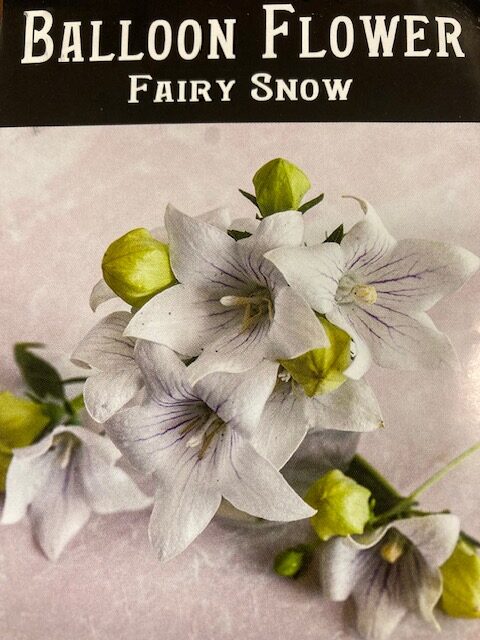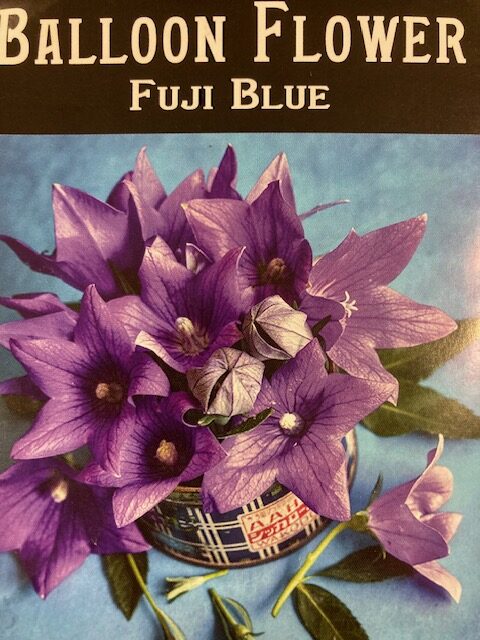
Balloon Flower
Balloon flowers get their name from the way the flower bud swells into a balloon shape and then burst open into stunning flowers. They come in a variety of colors ranging from blue, pink, purple, white, and other combinations!
|
Fairy Snow; Fuji Blue |
|
Platycodon grandiflorus |
|
Easy |
|
Easy |
|
3 years if properly stored (best guess) |
|
Perennial |
|
5-15 days |
|
65-75 F |
|
None |
|
Surface sow |
|
Yes Zones 3-9 |
|
Fairy Snow: <10” Fuji Blue: 2′ |
|
Seeds need light to germinate Full sun to part shade |
|
Summer |
|
March and April |
|
No |


Growing Tips


When to Start
Spring: Start indoors 6-8 weeks before the last frost date. (March/April for GA)
Direct Sow: After ALL danger of frost has passed. (May 1 for Jefferson, GA)
How to Grow
Start indoors 6-8 weeks before the last frost date. Use sterile, premoistened seed starting mix. Surface sow into seed cells or pots by gently press the seeds into the soil as light aids germination. Transplant the seedlings after hardening them off and all danger of frost has passed. Direct sow by gently pressing the seeds into the bed after all danger of frost has passed. Plant in full sun to part shade beds. Thin or space 1 foot apart.
Care
A perennial in zones 3-9 the balloon flowers prefer well-draining and slightly acidic soil. While the balloon flower will tolerate some dry spells, it will thrive with consistently moist soil. It does prefer cooler summer temperatures, so in areas where the summers get hot, afternoon shade would benefit the plant. Balloon flowers should remain upright but taller varieties may require staking. Deadhead for prolonged blooming and a tidier appearance.
In the fall, add a good layer of mulch for winter protection. Only divide when absolutely necessary as the plant abhors root disturbance.
Pruning
While pruning is typically not necessary, it can be done to create a more stocky plant and help prevent it from flopping over. Cut back the tall stems by half in late spring for a more stocky plant.
Seed Saving

Isolation Distance
According to Rareseeds.com, the balloon flower is the only member of the genus platycodon, so the seeds can be saved reliably without the chance of cross-pollination.
Instructions
Keep in mind, that while the balloon flower is the only member of its genus, there are differently colored flowers with in the genus. If growing several varieties of multiple colors, hand-pollinating and bagging blooms would be a good idea to preserve the color. Otherwise, you might end up with a mix of colors.
Select healthy, robust plants free of any signs of disease or insect infestation for seeds. Seeds carry the traits of the parent plant. Choose plants that exhibit the traits you wish to preserve. Consider bloom size, color, and shape, as well as blooming time.
Allow the biggest and healthiest blooms to mature on the plant. Cover the seed head with a fine-mesh bag as soon as the flower petals shrivel and die. Use an elastic band to hold the bag in place. This prevents seeds from spilling onto the soil before harvest.
Clip the flower head from the main stem once the seeds and flowers are dry and dark. Separate plant debris from the seeds by removing the mesh bag and placing the flower head in a paper bag and shaking to loosen the seeds. The seeds should readily shake from the pods. Seeds settle to the bottom of the bag. Remove plant debris by hand.
Features
- Container friendly
- Ornamental
- Deer resistant
- Attracts pollinators
- Low maintenance
- Fairy Snow: These dwarf plants bear ivory blooms with subtle lavender striping. They grow less than 10 inches tall.
- Fuji Blue: These plants will set off tons of blooms late into the season when many other flowers are spent.

The roots are edible, but DO NOT eat the leaves or flowers.
